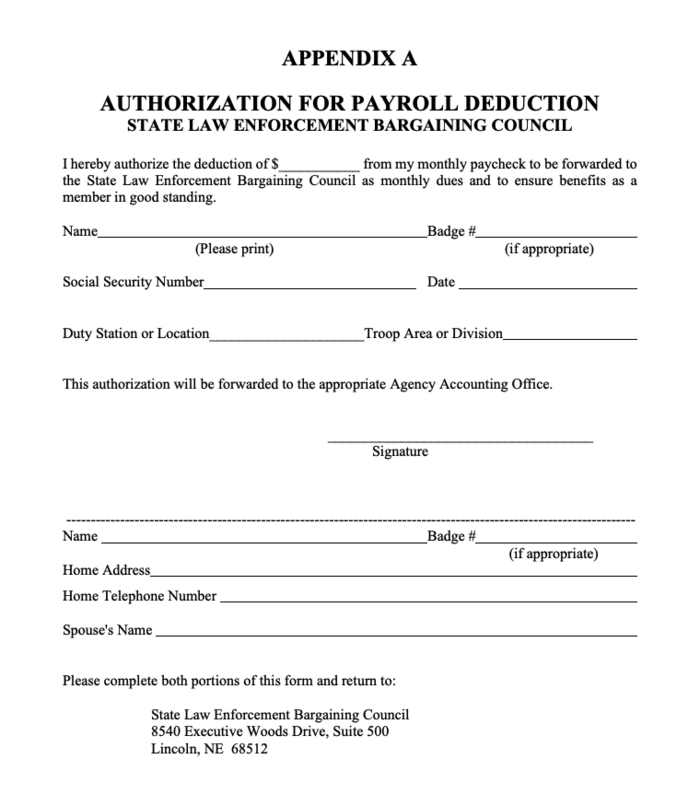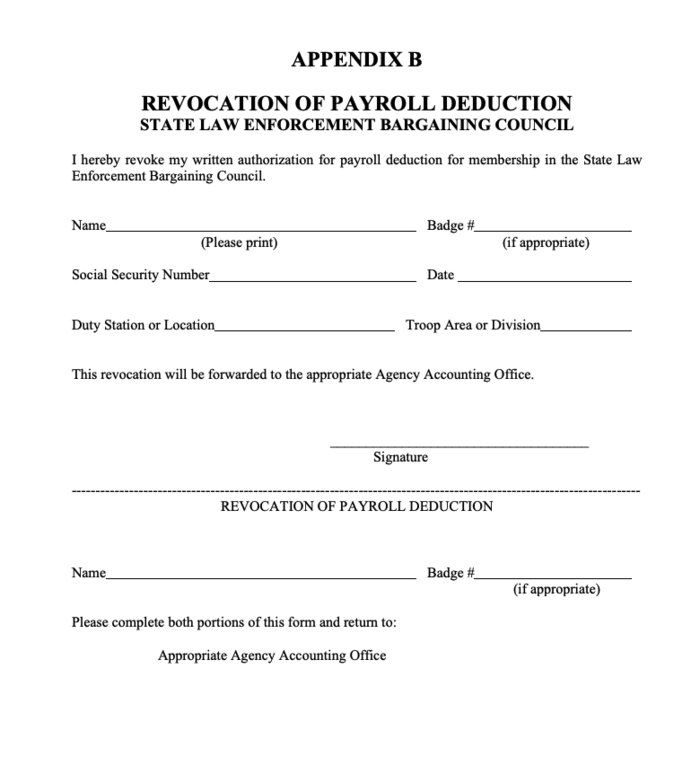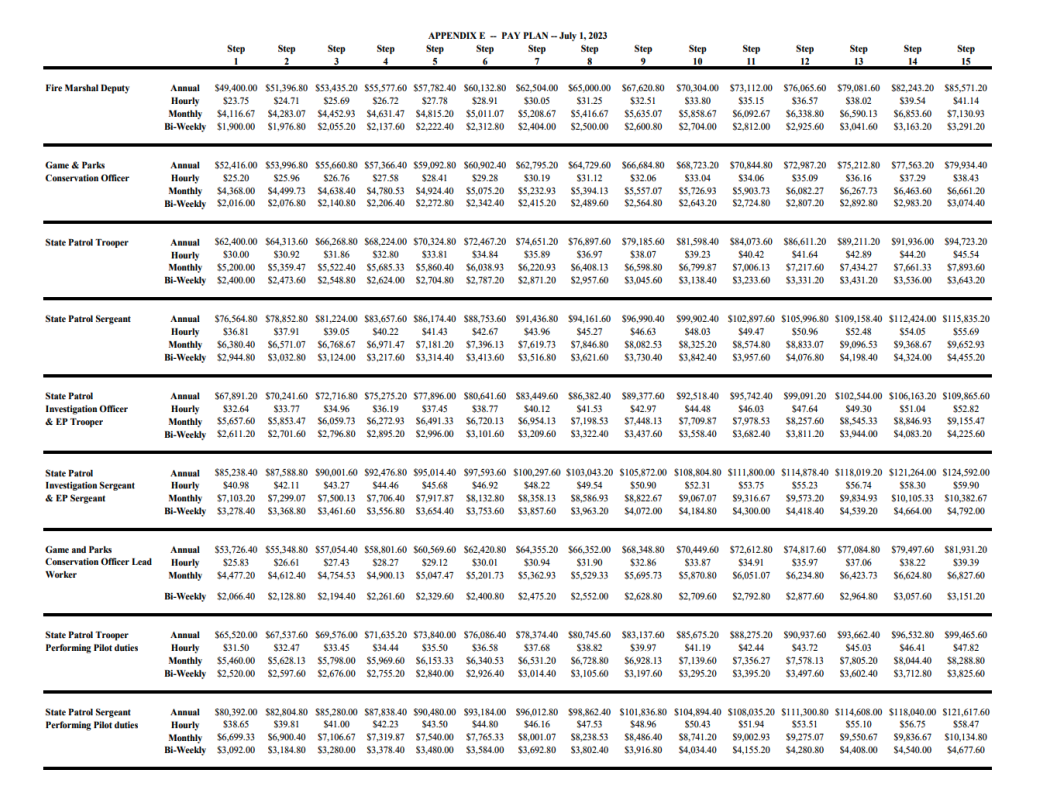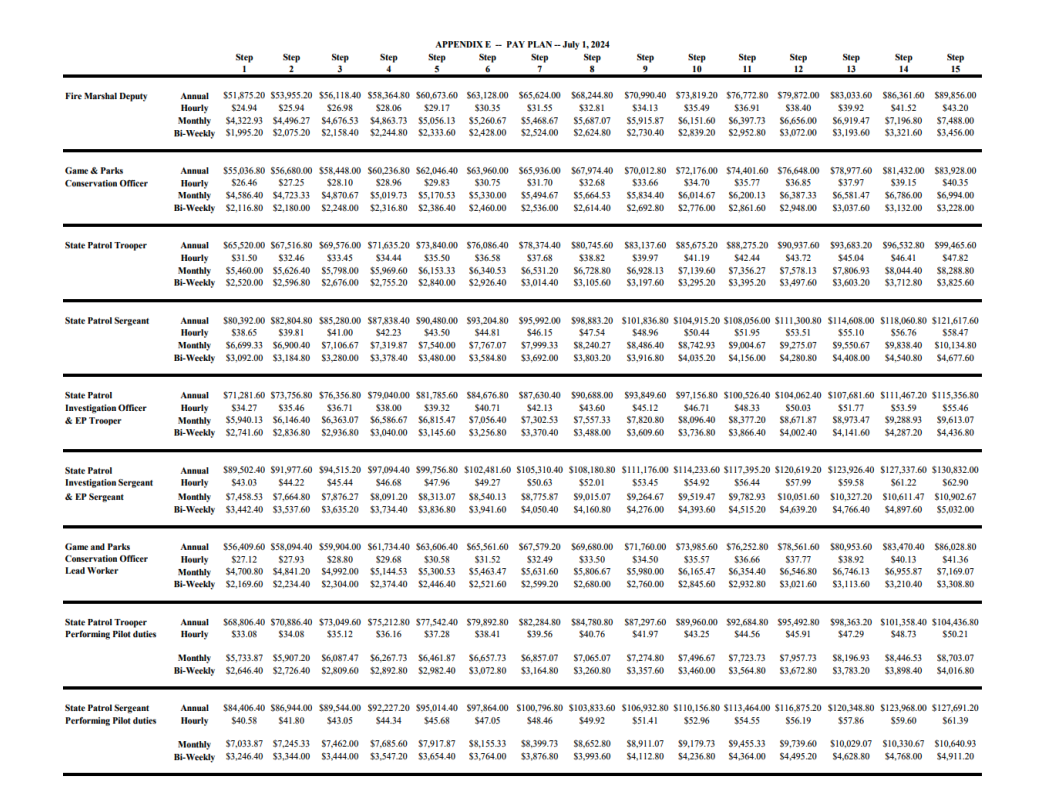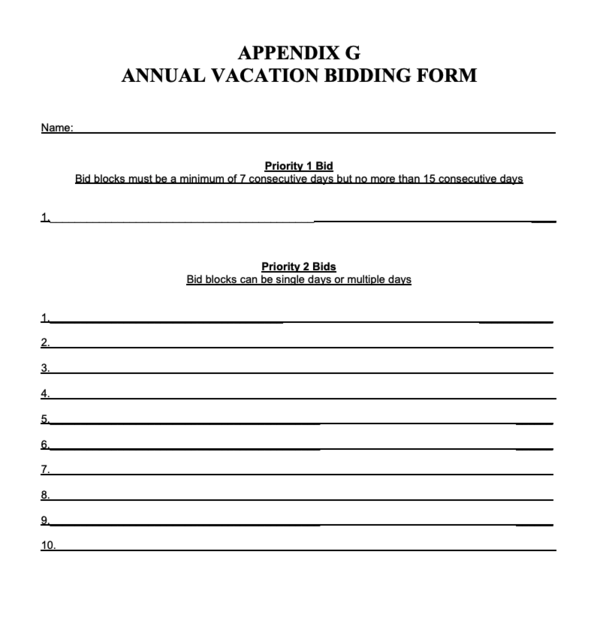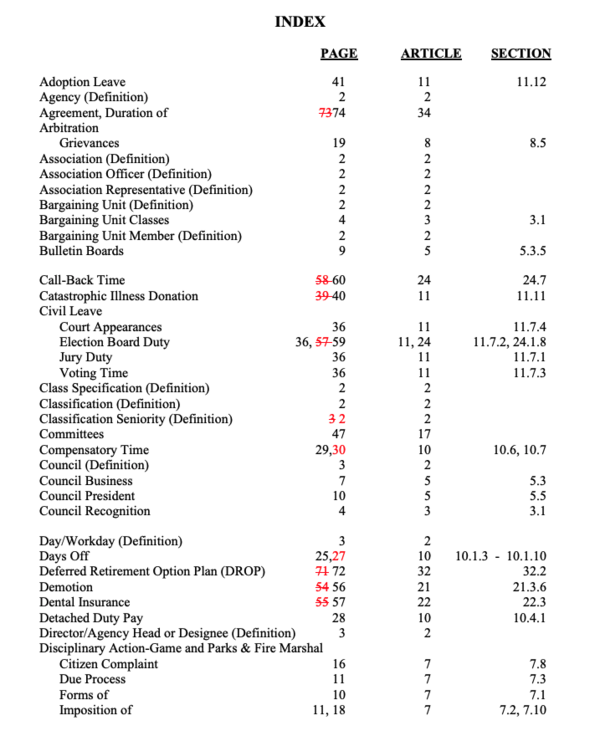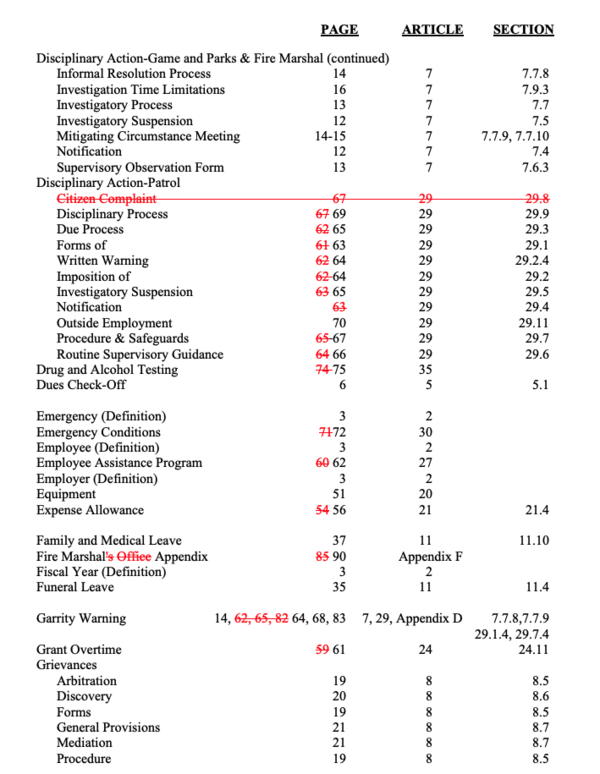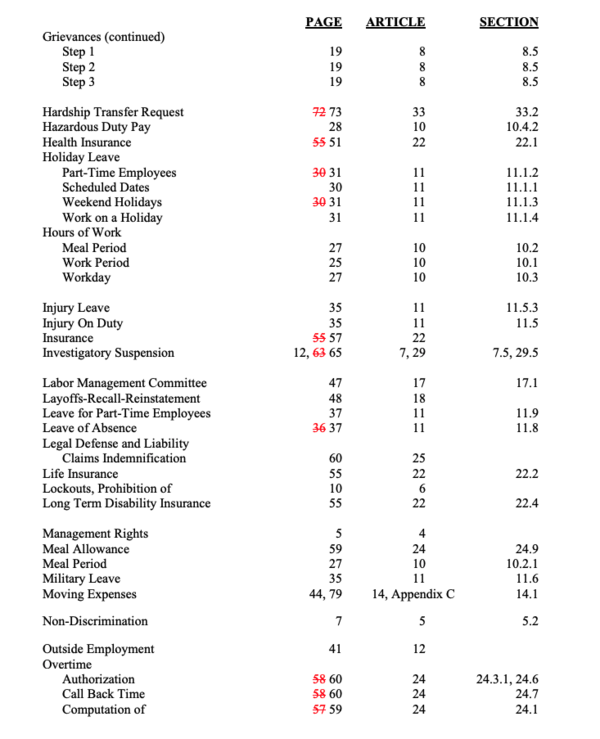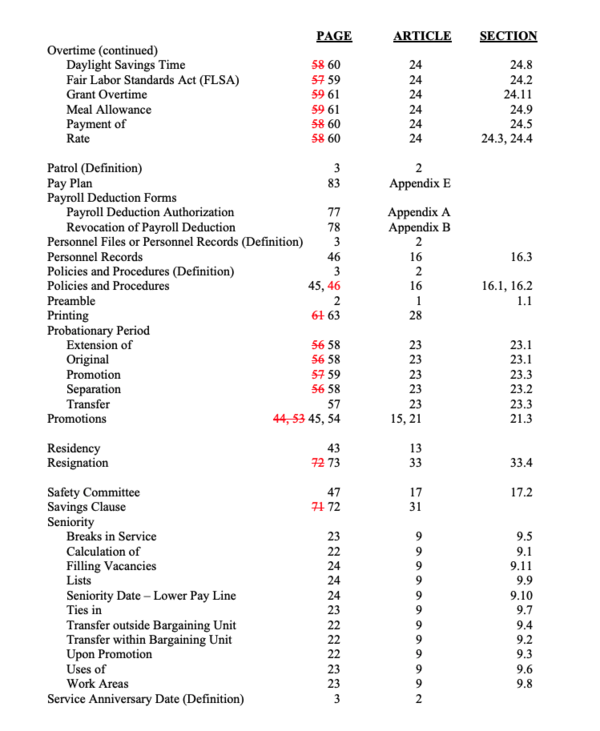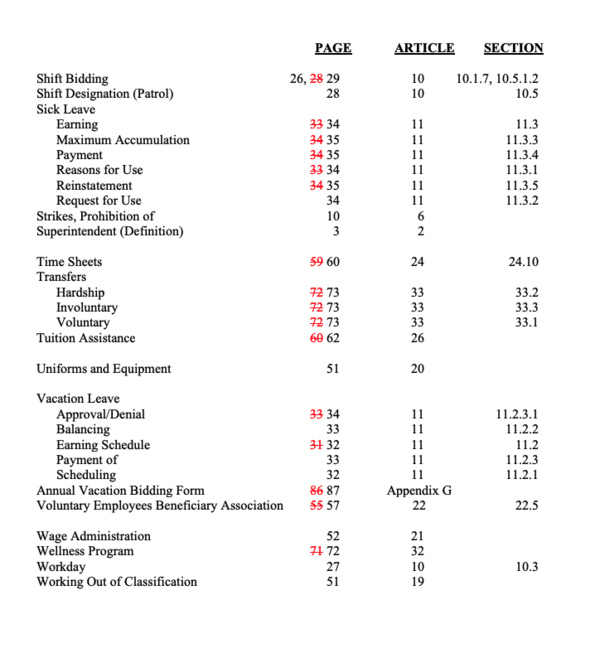|
11.1.1 The following holidays are compensated holidays for employees in the
bargaining unit and are scheduled on the dates indicated below:
[SEE NOTE 1 AT END OF ARTICLE FOR FULL TABLE]
11.1.2 Holiday Leave for Part-time Employees
Employees working part-time schedules shall receive paid time off for holidays
on a pro-rated basis.
11.1.3 Weekend Holidays
When a holiday falls on the first day of an employee's weekend, it shall be
observed on the preceding day. When a holiday falls on the last day of an
employee's weekend, it shall be observed on the following day. Normally, a
weekend is two consecutive days off, whether they be Saturday/Sunday,
Tuesday/Wednesday, Friday/Saturday, etc.
For employees whose normal schedule provides for a three day weekend, when a
holiday falls on the second day of the employee’s weekend, it shall be observed
on the first working day following the weekend.
11.1.4 Work on a Holiday
11.1.4.1 Holiday Compensatory Time Earned Prior to July 1, 2019
When used, holiday compensatory time shall not count towards the calculation of
overtime for the pay period. When holiday compensatory time is to be granted, it
shall be taken at the request of the employee with the approval of the immediate
supervisor. Bargaining unit employees will provide their immediate supervisor
with at least 72 hours’ notice of their intent to use holiday compensatory time.
All requests for the use of holiday compensatory time will be granted except
where minimum staffing requirements prohibit the approval of such requests.
Bargaining unit members, once notified of compensatory time balances in excess
of 240 hours who fail to schedule or refuse to schedule such excess time off, may
have time off scheduled by the agency on a date(s) determined by the Agency.
Employees ordered to take compensatory time off shall be provided at least 72
hours advance notice, unless a shorter notice is mutually agreed to. At the
Employer’s discretion, employees who accumulate over 240 hours of holiday
compensatory time will be paid the hours in excess of 240. At the employee’s
request, the Employer will provide the employee their holiday compensatory time
account balance information.
11.1.4.2 Compensatory Time Earned by Working on a Holiday After July 1, 2019
In addition to normal holiday pay/hours counted in a bargaining unit employee’s
overtime calculation, when employees are required to work on their designated
holiday they shall be compensated at the employer’s discretion in the form of
premium pay or compensatory time at a rate of time and one half for hours
actually worked on the holiday. Work on a holiday must be approved in advance,
by the immediate supervisor, except in the event of an emergency. When used,
compensatory time earned by working on a holiday shall not count towards the
calculation of overtime for the pay period. All hours worked on a holiday in
excess of an employee’s normally scheduled work day shall be compensated at
two times the employee’s normal hourly rate, in cash.
11.2 Vacation Leave
Earning of vacation leave by bargaining unit employees begins immediately upon
employment. Full-time employees earn vacation leave according to the following
schedule:
- 1st year through 5th year.................................................................. 96 hours
- 6th year........................................................................................... 120 hours
- 7th year........................................................................................... 128 hours
- 8th year........................................................................................... 136 hours
- 9th year........................................................................................... 144 hours
- 10th year......................................................................................... 152 hours
- 11th year......................................................................................... 160 hours
- 12th year......................................................................................... 168 hours
- 13th year......................................................................................... 176 hours
- 14th year......................................................................................... 184 hours
- 15th year......................................................................................... 192 hours
- 16th year and more……………………………………………….200 hours
11.2.1 Scheduling Vacation Leave
Vacation leave should be applied for in advance by the employee and may be
used only when approved by the Agency Head and/or his/her Designee. Vacation
leave may not be unreasonably denied or deferred so that the employee is
deprived of vacation rights.
11.2.1.1 Vacation leave requests shall be completed across all Sergeant Areas
/ Districts / Divisions twice per year. Troop Area / Division
Commanders shall refer employees under their command to Appendix
G by June 1st of each calendar year for the period starting August 1st
and ending January 31st and November 15th of each calendar year for
the period of February 1st and ending July 31st. Employees shall
complete their requests using Appendix G by June 15th and August
15th of each calendar year for each respective period. Troop Area /
Division Commanders shall process vacation leave requests and
notify those under their command of approvals/disapprovals by June
31st and August 31st of each calendar year for each respective period.
11.2.1.2 Priority 1 vacation leave requests shall consist of one leave request of
at least seven (7) calendar days but no more than fifteen (15) calendar
days. Priority 1 requests will be granted based upon seniority in the
employees' work areas. Ties in seniority shall be broken according to
the procedure set forth in Article 9.7 of this contract. Once granted, a
priority 1 request cannot be revoked and is transferrable upon
promotion, demotion, transfer (voluntary and involuntary), or change
in shift pursuant to Article 10 of this contract. A Priority 1 request can
be made into the next leave period but no request shall be granted
which exceeds the next leave period.
11.2.1.3 Priority 2 vacation leave requests shall be granted after all requests
pursuant to 11.2.1.2 have been granted. Appendix G shall have 10
spaces available for Priority 2 vacation leave requests. Priority 2
vacation leave requests can be for any length of time as long as the
hours in the employees leave bank(s) have or will have a sufficient
balance. Starting with the most senior officer, the first two Priority 2
vacation leave requests shall be granted. The next senior officer shall
then be granted their highest two Priority 2 vacation leave requests
that are available, and so on until all bargaining unit members have
had their first two Priority 2 vacation leave requests considered. Ties
in seniority shall be broken according to the procedure set forth in
Article 9.7 of this contract. All remaining Priority 2 vacation requests
shall be granted according to seniority. Once granted, Priority 2
vacation leave requests cannot be revoked unless a declared
emergency as defined in Article 2 of this contract is declared. Priority
2 vacation leave requests are not transferrable upon promotion,
demotion, transfer (voluntary and involuntary), or change in shift
pursuant to Article 10 of this contract.
11.2.1.4 Vacation leave requests by a bargaining unit member during the
progression of the current work period may be of any length of time.
Vacation leave requests shall be approved unless denied and written
notice of the denial is provided within 5 business days of receipt by a
member of the bargaining unit member’s chain of command.
11.2.2 Balancing of Vacation Leave
An employee’s accumulated vacation time in excess of 280 hours shall be
forfeited as of December 31st of each calendar year.
11.2.2.1 Conservation Officer’s accumulated vacation time which is in excess
of 280 hours shall be forfeited as of February 28, of the following
calendar year. This balancing of accumulated vacation time does not
include January and February earnings.
11.2.3 Vacation Leave Payment
Employees who leave employment shall be paid for any unused accumulated
vacation leave earned, calculated on their base hourly rate. Pay for the unused
accumulated vacation leave shall be in a lump sum addition to the employee's last
paycheck.
11.2.3.1 Other than set out as in Section 10.1.6, when an employee requests
time off on vacation leave such approval or denial will be given in
writing within at least 48 hours from the time the supervisor receives
the request. This will be documented in writing to the employee.
11.3 Sick Leave
Full time employees shall earn 13.5 days (108 hours) of sick leave per calendar year.
11.3.1 The following conditions are valid reasons that sick leave may be used.
11.3.1.1 When an employee is unable to perform his/her duties because of
sickness, disability, injury, or when an employee's presence at work
jeopardizes the health of others by exposing them to a contagious
disease. Pregnancy, post-natal recovery and miscarriage shall be
considered temporary disabilities.
11.3.1.2 When the illness, disability, or injury of an immediate family
member demands the employee's presence. The immediate family
shall be considered as: spouse, children, and parents (or persons
bearing the same relationship to the spouse). At the agency head's
discretion, the definition of immediate family may be broadened.
11.3.1.3 When an employee pre-schedules medical, surgical, dental or
optical examinations or treatment, or when the employee must seek
emergency medical treatment as set out in Section 11.3.1.2. A
reasonable attempt must be made to schedule such appointment
during non-work times.
11.3.1.4 The employer agrees that absence due to treatment related to
alcoholism or drug abuse, if medically diagnosed by a licensed
health care provider, shall constitute legitimate sickness.
11.3.1.5 In conjunction with an approved leave under the FMLA.
11.3.2 Request for Sick Leave
Sick leave shall be requested in advance when possible. The employee will make
contact with his/her shift supervisor, to report his/her illness, at least two hours
prior to the start of a shift. It is understood that there will be times when this
notice is not possible because of sudden illness, but the intent is to allow adequate
notice for shift coverage. In the case of illness, injury, emergency or any other
absence not approved in advance, the employee should inform the first level of
supervision of the circumstances as soon as possible. An employee may be
required to submit substantiating evidence when the reason for the leave request
was a medical or dental appointment or when the Agency Head and/or his/her
Designee suspects sick leave abuse. Substantiating evidence may be required if
the sick leave absence exceeds three consecutive workdays.
11.3.3 There shall be no maximum limit on accumulation of sick days.
11.3.4 All sick leave shall be forfeited upon separation from employment, except that an
employee who retires or dies shall be paid for forty-five percent
(45%) of his/her accumulated sick leave not to exceed six-hundred (600) hours.
11.3.5 Employees returning to work after a break in service of less than one calendar
year shall have their accumulated unused sick leave balance reinstated. Service
date shall be adjusted for the period of absence. Employees returning to work
after a break in service of more than one calendar year shall start with a zero sick
leave balance and shall be considered to be new employees for service date
purposes.
11.4 Funeral Leave
Up to 40 hours of funeral leave may be granted to employees for death in the immediate
family. For purposes of this section, immediate family shall mean spouse, father, mother,
grandfather, grandmother, sister, brother, child, grandchild, spouse of any of these, or
someone who bears a similar relationship to the spouse of the employee. Step-persons and
unborn persons bearing these relationships are included. At the Agency Head and/or
his/her Designee's discretion, the definition of immediate family may be expanded to
include other individuals with a similar personal relationship to the employee as that of an
immediate family member.
11.5 Injury on Duty
11.5.1 When a bargaining unit member is injured on duty and a bargaining unit member
is able to perform light duty, the Agency shall make every reasonable effort to
place said bargaining unit member in an assignment of light duty so as to not
cause him/her to expend his/her sick leave account. The Agency shall also
provide the unit member with information regarding light duty opportunities that
exist in the employment of the State of Nebraska outside the Agency. If a unit
member is offered a light duty position outside his or her Agency, the employee
shall not be required to accept the light duty assignment. The Agency may require
the bargaining unit member to provide a Physician’s Certificate regarding his/her
fitness to return to his or her regular duty assignment at any time.
11.5.2 Any disablement contracted in the course of employment shall be reported to the
proper Agency authority as soon as possible. The Employer shall report all
necessary information to the State's Worker's compensation authority.
11.5.3 All employees who are disabled as a result of a job-related injury or disease may
be granted injury leave not to exceed a maximum of forty hours for any particular
injury. A workday is counted even if an employee is absent for any portion of
their assigned shift. Disabled shall mean unable to perform the tasks usually
encountered in one's employment due either to an injury/disease or to treatment
for an injury/disease.
11.5.3.1 Any job-related injury or disease shall be reported to the proper
agency authority as soon as possible and the agency shall have the
responsibility to supply all the necessary information to the Office
of Risk Management.
11.5.3.2 No employee shall receive a salary (workers' compensation plus
regular pay) in excess of his or her normal wage.
11.6 Military Leave
Military leave shall be granted in accordance with applicable federal and state laws, and is
limited to 120 hours a year for drill, summer camp, deployment, training or other military
orders, with no accumulation of unused leave carried over to the following calendar year.
Such military leave may be taken in hourly increments. Employees who are members of
the National Guard or Reserve shall provide their Unit Training Assembly (drill) schedule
to their supervisor as soon as it is available from the Military Unit. Where practicable, the
Agency shall allow the employee to flex his/her work schedule to accommodate Unit
Training Assembly (drill) schedules.
11.7 Civil Leave: All employees shall be eligible for paid civil leave under the following
conditions:
11.7.1 Jury Duty: If an employee is called to serve as a juror, he/she shall be entitled to
paid civil leave. Employees will return to work when not actually serving as a
juror on a daily basis.
11.7.2 Election Board Duty: If an employee is appointed as a clerk or judge on an
election or counting board, he/she shall be entitled to paid civil leave. (For further
information on Election Board Duty, see section 24.1.)
11.7.3 Voting Time: All employees shall be allowed up to two paid hours for the
purpose of voting provided the employee does not have sufficient time before or
after regular duty hours to vote. The two hours authorized for voting does not
apply to those employees who by reasons of their employment must vote by use
of an absentee ballot.
11.7.4 Court Appearances: Time spent by employees appearing in court as a function
of their job shall be considered as hours worked. If witness fees and
reimbursements received as a result of these court appearances they shall be
returned to the State.
11.7.5 Employees attending courts as a plaintiff, defendant or witness on non-work
related matters, may use vacation leave or earned compensatory time. In the
event the employee is subpoenaed for non-work related matters and does not have
vacation leave or compensatory time the Agency Head and/or his/her Designee
shall grant a leave of absence. Any witness fees paid to the employee for these
court appearances shall be kept by the employee.
11.8 Leave of Absence
11.8.1 An Agency Head and/or his/her Designee may grant employees an unpaid leave
of absence, not to exceed one year (except for military service and some worker's
compensation cases), when such absences will not interfere with the best interest
of the state. Under unusual circumstances this time may be extended by the
Agency Head and/or his/her Designee. Written requests for leaves of absence
will be considered for such things as temporary disabilities (i.e. leave for
maternity, paternity), educational purposes, newly adopted children or other uses.
Medical leaves of absence shall not exceed six weeks unless approved by a
physician. The leave of absence when granted, shall be in writing and detail the
employment conditions that will be in effect at the end of the absence.
11.8.2 During the leave of absence, the temporarily vacated position may be filled by
either employing a temporary employee or assigning another qualified employee
to assume the duties of the position.
11.8.3 No benefits will accrue during a leave of absence.
11.8.4 Sick and vacation leave earned but unused prior to leave of absence will be carried
forward upon the employee's return.
11.8.5 The employee's service date shall be adjusted for non-pay absences in excess of
thirty calendar days, except when an employee is still eligible for worker's
compensation payments.
11.9 Leave for Part-Time Employees: All types of leave are granted in proportional amounts
for part-time employees.
11.10 Family and Medical Leave
11.10.1 Family and Medical Leave is unpaid time off from work. An employee must
have at least twelve total months of service and at least 1,250 hours of service in
the previous twelve month period to be eligible for Family and Medical Leave.
Temporary employment with the State of Nebraska counts toward an employee’s
eligibility. An employee can use paid vacation, accumulated compensatory time,
or sick leave (if the condition for using sick leave meets the sick leave criteria
outlined in Section 11.3.1.1 through 11.3.1.4) as part of their 12 weeks of Family
and Medical Leave if the employee should so choose.
11.10.2 Conditions for Using Family and Medical Leave.
Unpaid Family and Medical Leave may be used for the following reasons:
- a. Because of the birth of a child of the employee.
- b. Because of the adoption or placement of a foster care child with the employee.
- c. In order to care for the serious health condition of the employee’s spouse, child, or parent.
- d. Because of the serious health condition of the employee.
- e. Because of any qualifying exigency (as defined by the Secretary of Labor) arising out of the fact that the spouse, or a son, daughter or parent of the employee is on active duty (or has been notified of an impending call or order to active duty) in the Armed Forces in support of a contingency operation.
- f. Because the employee who is the spouse, the son, daughter, parent, or next of kin of a covered service member shall be entitled to a total of 26 workweeks of leave during a 12 month period to care for the service member. The leave described in this subsection f. shall only be available during a single 12 month period.
NOTE: Spouse does not include unmarried domestic partners. Child may
include step-children, foster children, or certain other children having more than
a short-term residence in the employee's home such as legal wards of the
employee. Care for mother-in-law or father-in-law is not included. However,
parent may include individuals other than natural or adoptive parents who served
in a long-term parental role for the employee.
NOTE: Serious health conditions are defined as illness, injury, impairment,
or physical or mental conditions that involve: (1) in-patient care, (2) absence
from work, school or other regular daily activities for more than three calendar
days and continuing treatment by a health care provider, or (3) continuing
treatment by (or under the supervision of) a health care provider for a chronic or
long-term health condition that is incurable or so serious that, if not treated, would
likely result in a period of incapacity of more than three calendar days, or prenatal
care. Examples of serious health conditions include: heart attack, heart by-pass
or valve operations, most cancers, back conditions requiring extensive therapy or
surgery, strokes, severe respiratory conditions, spinal conditions, appendicitis,
pneumonia, emphysema, severe arthritis, severe nervous disorders, need for
prenatal care, severe morning sickness, childbirth, and recovery from childbirth.
This does not include voluntary or cosmetic treatments, unless inpatient
hospitalization is required.
11.10.3 Certification of Serious Health Conditions. When requesting Family and Medical
Leave for serious health conditions, an employee must provide certification from
a health care provider which includes:
- (1) the date on which the serious health condition commenced;
- (2) the probable duration of the condition;
- (3) any appropriate medical facts;
- (4) a statement containing specific information why the employee is needed to care for the child, spouse, or parent, or; a statement containing specific information why the employee is unable to perform the functions of the job;
- (5) if the leave is to be intermittent, a statement containing specific information concerning planned medical treatments, the expected dates and duration of treatment.
11.10.3.a. Medical Second Opinions. The Agency may require a second
opinion (the Agency's choice of health care provider) and must
pay for the cost of the second opinion. If the second opinion
differs from the first, a third opinion may be sought (from a
mutually agreed upon health care provider, again, at the
Agency's expense). The results of the third opinion are final.
11.10.4 Notice of Intent to Use Family and Medical Leave. A minimum of 30 days notice
to the Agency must be provided by the employee before he or she may use Family
and Medical Leave. Where 30 days notice is not foreseeable, notice must be
given as early as possible.
11.10.5 Family and Medical Leave Duration. Unpaid Family and Medical Leave is
limited to a total of twelve weeks within a twelve month period, starting with the
date the employee first uses unpaid Family and Medical Leave, except that the
leave under Section 11.10.2.f may be 26 weeks during a single 12-month period,
but the leave provided under 11.10.2.e and 11.10.2.f cannot exceed a combined
total of 26 weeks during a 12 month period.
11.10.6 Family and Medical Leave Not Cumulative. Family and Medical Leave cannot
be carried forward beyond the twelve month period and banked for future use.
11.10.7 Incremental Use of Family and Medical Leave. With approval of the agency,
Family and Medical Leave may be taken in increments with proper medical
certification (federal law allows employees not eligible for overtime, "exempt
employees", to make incremental use of unpaid Family and Medical Leave
without affecting their “salaried” status).
11.10.8 Health Insurance while on Family and Medical Leave. Employer health
insurance contributions shall continue during an employee’s unpaid Family and
Medical Leave absence, provided the employee makes his/her required
contribution. Employer contributions shall be based as if the employee had
continued to work his/her normal schedule.
11.10.9 Service Date Adjustments. The employee’s Service Date shall be adjusted when
an unpaid absence due to Family and Medical Leave exceeds 30 consecutive
calendar days.
11.10.10 Family and Medical Leave Denials. DAS Employee Relations Division shall be
notified by the Agency of any requests for Family and Medical Leave which are
denied.
11.11 Catastrophic Illness Donation
11.11.1 Conditions for Contributing Vacation Leave or Compensatory Time. The
provisions of this section are nongrievable. Employees may contribute accrued
vacation leave or compensatory time to benefit another State employee in the
same agency suffering from a catastrophic illness. Catastrophic condition is
considered a life threatening medical condition or an injury or illness that causes
the employee to suffer a substantial temporary disability.
Vacation/compensatory leave shall be donated in no less than four (4) hour
increments. The contributing employee must identify the specific amount of time
donated and the name of the recipient for the donated vacation/compensatory
leave on forms provided by the Employer for this purpose.
Vacation/compensatory leave donated and transferred to another State employee
pursuant to this provision shall be irrevocably credited to the recipient’s
catastrophic illness account. The recipient cannot use the donated leave until the
date the leave is actually donated. The agency shall transfer donated leave to the
recipient’s account on an as needed basis. However, the agency shall not transfer
more than the equivalent of 30 of the recipient’s workdays of leave into his/her
account at any one time.
11.11.2 Conversion of Leave. Leave for catastrophic illness will be available only to
employees who have exhausted their own paid leave and compensatory
time/leave through bona fide serious illness or accident. Donating employees
must sign an authorization, including specifying the specific employee to be a
recipient of the donation. Leave transferred will be converted to a dollar value
and then converted to hours based on the recipient’s hourly rate e.g., the leave
donor’s salary is $6.00 per hour and the recipient’s salary is $12.00 per hour; thus
a donor must transfer twice the amount of hours to achieve full conversion. The
agency shall not transfer more than the equivalent of 30 of the recipient’s
workdays of leave into his/her account at any one time. The agency shall not
transfer more donations until this amount is exhausted. All donations remaining
in the employee’s catastrophic illness account when the employee’s employment
terminates, or when the employee dies, shall be forfeited, and no payout for these
forfeited hours shall be made. No more than 1,200 hours of donated leave may
be received by an employee during a twelve month period.
11.11.3 Eligibility of Recipient. The Recipient must meet all of the conditions listed
below:
- a. Must be suffering a serious illness or injury resulting in a prolonged absence of at least thirty work days during the past six months.
- b. Must produce satisfactory medical verification.
- c. Must have completed original probation.
- d. Must have exhausted all earned paid leave time including compensatory time off, sick leave, and vacation leave.
- e. Must not have offered anything of value in exchange for the donation.
- f. Has not received catastrophic leave donations for serious illness or injury in the past 2 years.
11.11.4 Eligibility of Donor Employee. The donor employee must meet all of the
conditions listed below:
- a. Only four (4) hour increments of vacation/compensatory leave may be donated.
- b. Must not have solicited nor accepted anything of value in exchange for the donation.
- c. Must have remaining to his/her credit at least 40 hours of accrued vacation leave, after donating vacation leave.
11.12 Adoption Leave: Upon request, the mother of newly adopted children, meeting the
requirements of Neb. Rev. Stat. Sec. 48-234, shall receive the same sick leave allowed to
State employees who are new mothers by natural birth (generally six weeks) when adopting
a child. Fathers of newly adopted children, meeting the requirements of Neb. Rev. Stat.
Sec. 48-234, should receive leave on the same terms as fathers by natural birth.[2]
|



